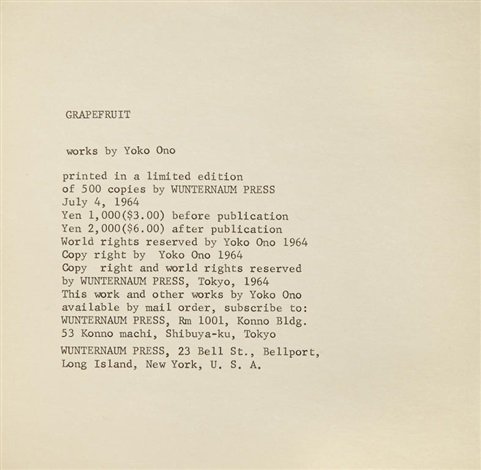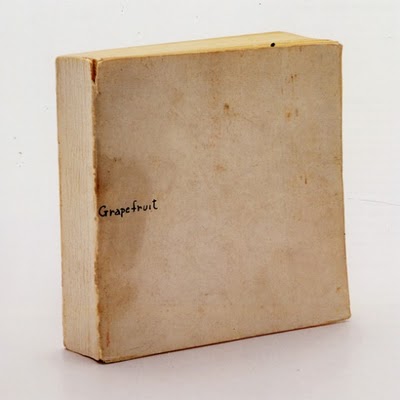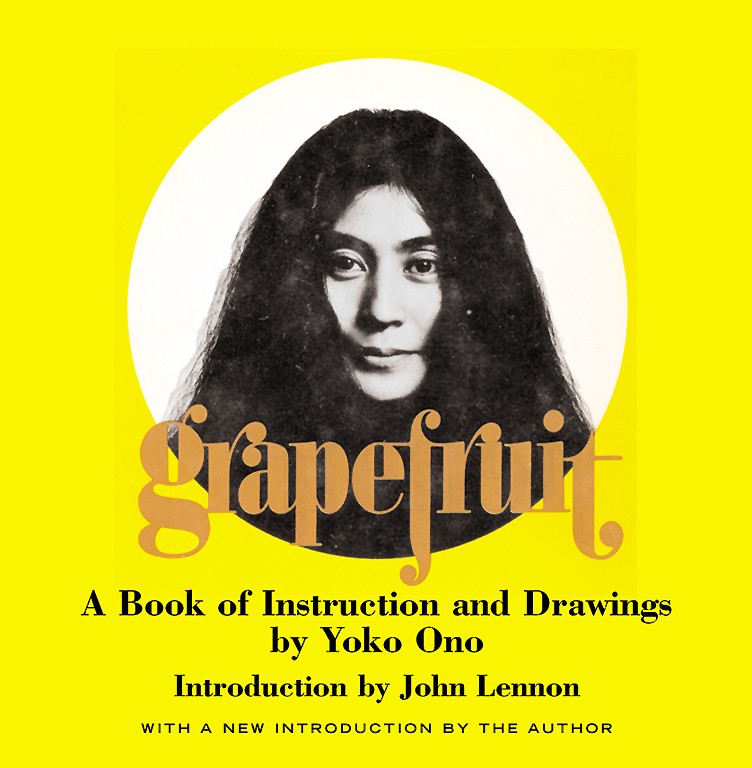

Yoko Ono’s work is in the collection of the Hirshhorn Museum and Sculpture Garden. Grapefruit offers unparalleled insight into the zeitgeist of the early 1960s when Ono became an influence on Feminism, Conceptualism, and media art. Paging through the book, readers can immerse themselves in Ono’s work- taking the book’s instructions literally or constructing her art with their imaginations.
#Yoko ono grapefruit plus#
This 1970 edition features the original five sections- Music, Painting, Event, Poetry, Object- with a cheeky introduction by John Lennon, plus new works by Ono. This artist’s book contains “event scores,” instructions that the reader may choose to follow in order to perform a proposed piece of art. Originally published in 1964, Yoko Ono’s Grapefruit: A Book of Instructions and Drawings is a foundational work of conceptual art. Allowing us to clear our mind and think of ourselves as artists. “There are one thousand suns rising every day.You may rewind the clock but never reset it. Her book, even to this day, is a breath of fresh air. Call every day and talk about many things,” and “Take the sound of a stone aging.” All easily executed, even by those who do not consider themselves to be artists of any kind. Instructions include: “Get a telephone that only echoes back your voice.

It is a book of instruction that seeks to demonstrate that art could be reduced to a set of rules that anyone could execute. The book requires readers to take part of the journey, to participate in the art, and even encouraging in the creation of art. This is, of course, if one begins the reading with an open mind, ready to be taken on a journey with passages only a couple of lines long.

While reading “Grapefruit,” the reader will find himself or herself laughing, questioning, and pondering on life. The book lives on more than 50 years later. “Grapefruit,” was an art book by Ono which was published two years before she first met John Lennon. Perhaps they will curiously observe audience members cut Ono’s clothing in her provocative art piece by the name of “Cut Piece.” Maybe they will find themselves thinking how about wishes to add to her “Wish Tree,” an ongoing art installation which she started in 1981. We can only hope that those who are curious enough to find out more about this woman who was so special to John Lennon, will put in motion some investigative skills and find themselves examining Ono’s typically interactive art. Still some hardcore Beatles’ fans and even regular civilians with no ties to “The Beatles” whatsoever seem to have the misguided belief that Yoko Ono is the source of evil when it comes to the English rock band. Even Paul McCartney (who is a pretty cool dude), will back up her claim. Yoko Ono is now 83 years old, and even 45 years after the dissolution of The Beatles, she finds herself setting the record straight by assuring those who will listen that she had nothing to do with the famous band breaking up. This is a term that is not exactly popular but can be rather catchy after heard for the first time. What exactly is Yokophobia? One might be inquisitive enough to wonder. Find out which iconic song was inspired by this pioneering book with Karen ORourke, curator of the Double Fantasy: John & Yoko exhibition. In fact, I am not innocent in this matter, given that even I first became acquainted by Yoko Ono through what is referred to by some as “Yokophobia.” Yoko Ono published Grapefruit 55 years ago. Back in print for the first time in nearly thirty years, here is Yoko Onos. You are familiar with Ono for the international artist that she is and was before and after her dramatic love story with John Lennon which produced mostly negative waves across the world among The Beatles’ fans. Grapefruit: A Book of Instructions and Drawings by Yoko Ono (Hardcover). If you have found yourself reading this piece, there is a high possibility your recognize Yoko Ono’s name without necessarily associating her with the dissolution of the Beatles. “Walk all over the city with an empty baby carriage:” sound advice given by Yoko Ono in her book titled “ Grapefruit ” which was first published in 1964.


 0 kommentar(er)
0 kommentar(er)
